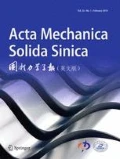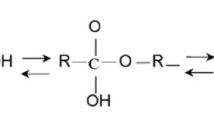Abstract
This paper studies the effects of hygrothermal environment at different temperatures and ultraviolet (UV) radiation on the bending properties of epoxy polymer mortar (EPM). The microstructure changes of EPM during aging were studied by scanning electron microscopy, and the bending properties of EPM were predicted by the Arrhenius law. The results showed that the bending properties of EPM were greatly affected by the temperature in the hygrothermal aging, but not evidently affected by ultraviolet radiation in UV aging. The prediction of Arrhenius model shows that the EPM will steadily retain 92.8%, 89.1% and 79.4% of the original flexural strength after long-term hygrothermal aging at \(40^{\circ }\)C, \(60^{\circ }\)C and \(80^{\circ }\)C, respectively.








Similar content being viewed by others
References
Bedi R, Chandra R, Singh SP. Mechanical properties of polymer concrete. J Compos. 2013;2013:1–12.
Reis JML, Ferreira AJM. A contribution to the study of the fracture energy of polymer concrete and fibre reinforced polymer concrete. Polym Test. 2004;23(4):437–40.
Davydov SS, Solomatov VI, Shvidko YI. Epoxy polymer concrete. Hydrotech Constr. 1970;4(9):849–52.
Ma D, Liu Y, Zhang N, et al. Micromechanical modeling of flexural strength for epoxy polymer concrete. Int J Appl Mech. 2017;9(8):1750117.
Mo LT, Fang X, Yan DP, et al. Investigation of mechanical properties of thin epoxy polymer overlay materials upon orthotropic steel bridge decks. Constr Build Mater. 2012;33:41–7.
Wang J, Dai Q, Guo S, et al. Mechanical and durability performance evaluation of crumb rubber-modified epoxy polymer concrete overlays. Constr Build Mater. 2019;203:469–80.
Yin J, Zhang J, Wang W, et al. Effective resin content and its effect on the overall performance of polymer concrete for precision machine tools. Constr Build Mater. 2019;222:203–12.
Haddad H, Al Kobaisi M. Optimization of the polymer concrete used for manufacturing bases for precision tool machines. Compos B Eng. 2012;43(8):3061–8.
Ahn S, Kwon S, Hwang Y, et al. Complex structured polymer concrete sleeper for rolling noise reduction of high-speed train system. Compos Struct. 2019;223:110944.
Ferdous W, Manalo A, Aravinthan T, et al. Properties of epoxy polymer concrete matrix: Effect of resin-to-filler ratio and determination of optimal mix for composite railway sleepers. Constr Build Mater. 2016;124:287–300.
Cavasin M, Sangermano M, Thomson B, et al. Exposure of glass fiber rein-forced polymer composites in seawater and the effect on their physical performance. Materials. 2019;12(5):807.
Nikafshar S, Zabihi O, Ahmadi M, et al. The effects of UV light on the chemical and mechanical properties of a transparent epoxy-diamine system in the presence of an organic UV absorber. Materials. 2017;10(2):180.
Rashid K, Wang Y, Ueda T. Influence of continuous and cyclic temperature durations on the performance of polymer cement mortar and its composite with concrete. Compos Struct. 2019;215:214–25.
Cheng J. Study on the impact and aging properties of epoxy based concrete. South China University of Technology. 2016 (in Chinese).
Fiore V, Di Bella G, Valenza A. The effect of alkaline treatment on mechanical properties of kenaf fibers and their epoxy composites. Compos B Eng. 2015;68:14–21.
Coniglio N, Nguyen K, Kurji R, Gamboa E. Characterizing water sorption in 100% solids epoxy coatings. Prog Org Coat. 2013;76(9):1168–77.
Niu Yifan, Li Zhangqi, Zhu Xiaofeng. Flexural properties and life-time estimation of carbon fiber/epoxy composite under hygro-thermal condition. Acta Materiae Compositae Sinica. 2020;37(1):104–12 (in Chinese).
Reis JML, Ferreira AJM. The effects of atmospheric exposure on the fracture properties of polymer concrete. Build Environ. 2006;41(3):262–7.
Reis JML, Ferreira AJM. Effect of marine exposure on fracture properties of epoxy concretes. Polym Test. 2005;24(1):121–5.
Reis JML, Carvalho AR, Da Costa Mattos H S. Effects of displacement rate and temperature on the fracture properties of polymer mortars. Constr Build Mater. 2014;55:1–4.
Oussama E, Elhem G, Valerie M, Mongi BO, et al. Mechanical and physical properties of epoxy polymer concrete after exposure to temperatures up to 250 \(^{\circ }\). Constr Build Mater. 2012;27(1):415–24.
Khotbehsara MM, Manalo A, Aravinthan T, et al. Ageing of particulate-filled epoxy resin under hygrothermal conditions. Constr Build Mater. 2020;249:118846.
Ma D, Pan Z, Liu Y, et al. Residual flexural performance of epoxy polymer concrete under hygrothermal conditions and ultraviolet aging. Materials. 2019;12(21):3472.
Sinopec Beihua Institute National Chemical Building Materials Testing Center (Material Testing Department). Plastics-Determination of flexural properties: GB/T 9341-2008. 2008 (in Chinese).
American Society of Testing Materials. ASTM G154–16 Standard practice for operating fluorescent ultraviolet (UV) lamp apparatus for exposure of nonmetallic materials. American: ASTM; 2012.
Park SY, Choi WJ, Choi CH, et al. An experimental study into aging unidirectional carbon fiber epoxy composite under thermal cycling and moisture absorption. Compos Struct. 2019;207:81–92.
Perrier A, Le Bourhis E, Touchard F, et al. Effect of water ageing on nanoindentation response of single hemp yarn/epoxy composites. Compos Part A Appl Sci Manuf. 2016;84:216–23.
Acknowledgements
The study is financially supported by the National Natural Science Foundation of China (Grant Nos. 12072116, 11772132, 12072115, 11772131, 11772134, 11972162 and 11932007).
Author information
Authors and Affiliations
Corresponding authors
Rights and permissions
About this article
Cite this article
Li, X., Ma, D., Lu, Z. et al. Experimental Study of Hygrothermal and Ultraviolet Aging on the Flexural Performance of Epoxy Polymer Mortar. Acta Mech. Solida Sin. 34, 539–549 (2021). https://doi.org/10.1007/s10338-021-00234-y
Received:
Revised:
Accepted:
Published:
Issue Date:
DOI: https://doi.org/10.1007/s10338-021-00234-y




